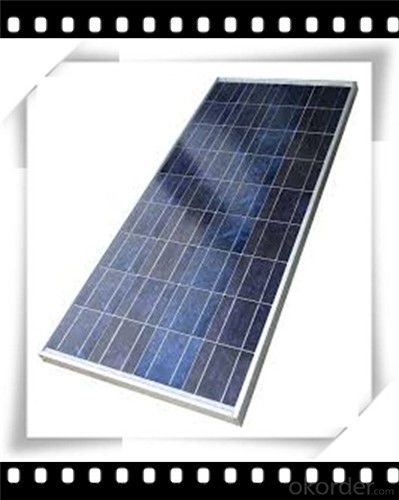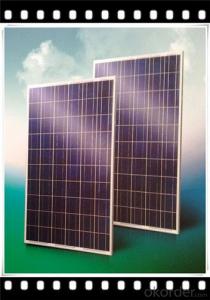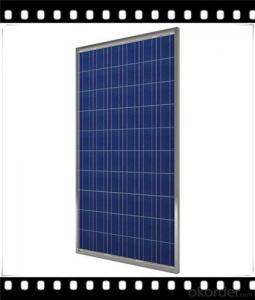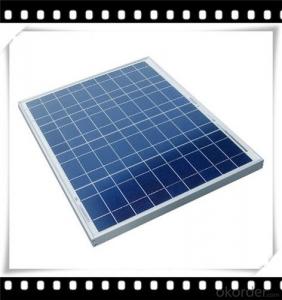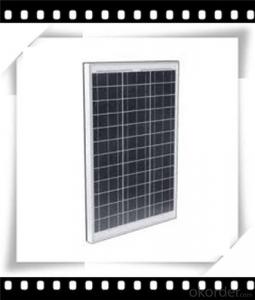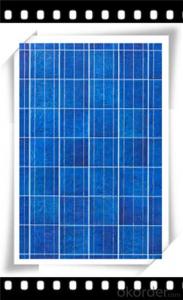370 Watt Poly Solar Panel Mini Solar Panel Hot Selling Solar Panel CNBM
- Loading Port:
- Qingdao
- Payment Terms:
- TT OR LC
- Min Order Qty:
- 10 set
- Supply Capability:
- 300000 set/month
OKorder Service Pledge
OKorder Financial Service
You Might Also Like
Polycrystalline Solar Modules
CNBM offers a range of small, medium and large polycrystalline solar modules, designed for a range of requirements.
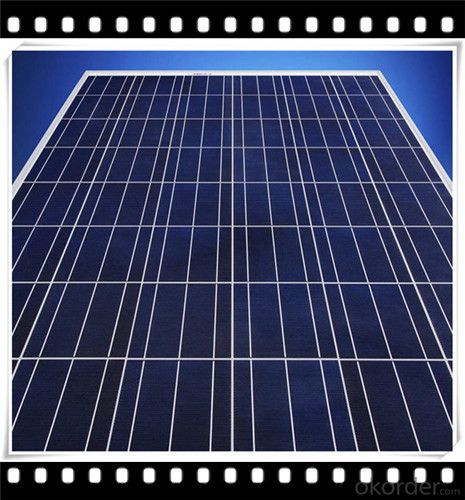
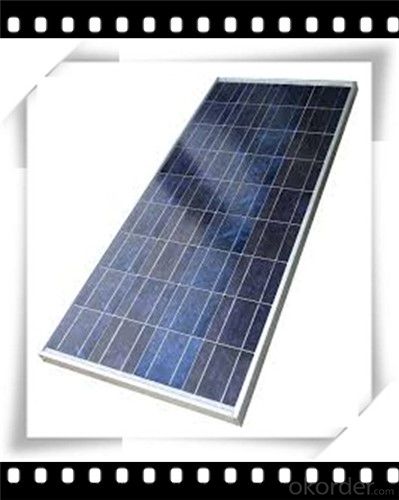
Specifications:
+/-3% |
Polycrystalline silicon solar cells (156 x 156mm) |
60 (10 x 6) |
1650 x 990 x 40 |
25.5 |
Limits:
Operating Temperature | -40~+85? |
Storage Temperature | -40~+85? |
Maximum System Voltage | 1000 VDC max. |
Hail Impact | Diameter of 28mm with impact speed |
Temperature and Coefficients:
NOCT | 48C+/-2? |
Voltage temperature coefficient (%/K) | -0.35 |
Current temperature coefficient (%/K) | 0.05 |
Power temperature coefficient (%/K) | -0.45 |
Characteristics:
Model: | SGM-200P | SGM-210P | SGM-220P |
Max-power voltage Vmp (V) | 29.2 | 29.4 | 29.41 |
Max-power current Imp (A) | 6.85 | 7.14 | 7.48 |
Open-circuit voltage Voc (V) | 36.5 | 36.69 | 36.9 |
Short-Circuit Current Isc (A) | 7.28 | 7.6 | 7.93 |
Max-power Pm(W) | 200 | 210 | 220 |
Model: | SGM-230P |
Max-power voltage Vmp (V) | 29.8 |
Max-power current Imp (A) | 7.72 |
Open-circuit voltage Voc (V) | 37.31 |
Short-Circuit Current Isc (A) | 8.19 |
Max-power Pm(W) | 230 |
STC: Irradiance 1000W/m2, module temperature 25?, AM-=1.5
Poly Crystalline Solar Panels Specifications Range
Maximum Power (Pm) | Dimension | Weight | Operating Voltage (Vmp) | Operating Current (Imp) | Open Circuit Voltage (Voc) | Short Circuit Current (Isc) |
0.45W | 140x80x10mm | 0.08kg | 3.3V | 150mA | 4.6V | 160mA |
1.0W | 162x140x10mm | 0.16kg | 7.5V | 150mA | 10.3V | 160mA |
4.5W | 269x251x23mm | 0.8kg | 16.5V | 0.27A | 20.5V | 0.3A |
10W | 420.1×268.9×22.6mm | 1.92kg | 17.5V | 0.58A | 20.5V | 0.6A |
20W | 425x502x50mm | 3.0kg | 16.8V | 1.19A | 21.0V | 1.29A |
30W | 593x502x22.6mm | 3.9kg | 16.8V | 1.78A | 21.0V | 1.94A |
40W | 655x537x50mm | 5.75kg | 17.3V | 2.31A | 22.1V | 2.54A |
50W | 839x537x50mm | 6.0kg | 17.5V | 2.9A | 21.8V | 3.17A |
65W | 1111x502x50mm | 7.2kg | 17.6V | 3.69A | 22.1V | 3.99A |
80W | 1204x537x50mm | 7.7kg | 17.6V | 4.55A | 22.1V | 4.8A |
- Q: Solar panel experiment ?wat are some experiments with solar panels that has not yet been proven? ideas
- You okorder /
- Q: Is it possible to store energy from solar panels for night?
- Solar Power At Night
- Q: I know absolutely nothing about electronics but have a lot of money. I am thinking of buying the Sunforce 3730 30W monocrystalline solar panel (the best I could find that was that size or smaller). What would be a good battery to go with it? I am thinking of buying a 2V Concorde Sun Xtender (again, the best I could find). But how many batteries will I need? I want enough batteries that it would take the solar panel 2 days to completely charge them from empty (bearing in mind the unavoidable inefficiencies like cloudiness/changing sun angles). Also, what other stuff would I need, like I hear something about a quot;charge controllerquot;? Any suggestions would be appreciated.
- If you are at a location/time where the panel will put out less power, you can adjust the battery size accordingly. And running a battery to empty is very bad for it's service life, so it's better to go a bit bigger.
- Q: I'm looking to mount a solar panel to the top of my 2003 Pontiac Montana and was wondering how i could do it without any screws? Magnets maybe?
- What mark said about shade is true, but take into account that the solar panel will absorb most of that heat. That is how they work they absorb the energy (heat) from the sun and transfer it into useable power.
- Q: I've been reading up on Solar panels because I think in the long run this would be beneficial in the long run. My Dad had looked into it before passing and had said it was too expensive. How much does it range for getting them placed on the roof and how exactly does that work? I think I remember being told that PGE has incentives and could possibly even end up paying you for having it? What does having panels cover? I know electricity but does it also heat things up? Sorry I'm kinda dee dee dee on this lol. Any and all information would be greatly appreciated. If anyone has solar panels can I get your experiences with them? Thanks!!
- By producing even a small portion of your home's electricity through the use of solar panels, you will eventually experience some financial savings. This may take five years or so, but good solar panels often have a 20-year lifespan. State and federal tax credits may help offset their initial expense. The best thing about solar panel installation is that the energy it produces is clean, meaning that there aren't any bad or harmful by-products produced during the process of electricity generation. So all in all, it seems that solar energy is clean, green energy.
- Q: Can solar panels be installed on a remote island or location?
- Yes, solar panels can be installed on a remote island or location. Solar panels are a versatile and sustainable energy source that can be easily installed in off-grid areas. They do not require a constant supply of fuel or a connection to the main power grid, making them ideal for remote locations where traditional energy sources are scarce or expensive to transport. Solar panels can provide reliable electricity to power homes, businesses, and infrastructure, allowing remote islands or locations to become more self-sufficient and environmentally friendly.
- Q: Aren't batteries bad for the environment?Toxic?Expensive? With small solar panels phones, iPod's, laptops other small electronics could be smaller, slimmer, more efficient cost people less to charge every day. Maybe a small battery inside as a backup and to store the Solar energy for night time. But overall, batteries should be optional. So big question:Why aren't electronics being produced with solar panels?
- Yes your right, solar panels (photovoltics) could be used to make electricity for small electronics. Right now solar cells are on many calculators, and even flashlight. But the problem is the lenght of time the cells take to charge the device, verses the power demand. I don;t think the size of the panels, and the amount of time needed to charge the device are practical. One think I have been thinking is that every one should have a photovoltaic panel to charge a battery. Then, use the battery to charge cell phones, MP3 palyers. The panel and the battery could be about the 8 x inches, and could sit in window, or on a dash board to get charged, then used in doors over night to charge devices.
- Q: I am doing a project for school and i need to power a 9v DC motor using a solar panel. Does anyone know places i could get these for not to expensive, and how many volts/watts i would need?
- Jameco okorder /
- Q: I have seen quite a few different websites that talk about building your own solar panels for around $200. I wanted to know if anyone has had any experience with this before I decide to try it myself. It would be very helpful to know what I can expect from such an inexpensive setup; what kind of electronics or appliances would I be able to power. Realistically what can I expect from a $200 setup, and what would I need to power say a whole bedroom (clock, regular sized TV, PC, ext.).
- Hello, okorder . Look at some videos ( There are few hundred of them ) Basically though they all stay with the same idea or plan. Look at how they wire them and get more familiar with what they are running on them depending upon how much wattage panel they are running. I seen a 400 watt system costing about 600 dollars US currency. Because two 200 watt panels = 50.00 each and the diverter = 50 and the charge controller = another 50.00 at the least. Then you have wiring and some deep cycle 2 or 6 volt batteries to loop up which is extra cost if none laying around to use. Check-out youtube though for the best advice and opinion you can give yourself then maybe look at a few solar panel websites which sell Solar kits for some more price ideas. To run a laptop i assume you will need atleast 400 watts and 2 to 4 ,twelve volt batteries which are deep cycle and it might take 3 to 5 days to charge up your batteries but they should charge laptop battery no problem without much loss if you keep laptop charged often. TV is power hungry and you will need something like a $500.00 system for that. 000 watts etc. Tv just drains the battery bank way too fast. So to answer your question about what you can get for 200 bucks. Maybe a 80 watt kit system for about 250 bucks complete except batteries. with 80 watts you could power some cool nighttime night lighting with super bright LEDS or LED light strips which are about 0.3 watts per LED or 5 watt LED cabinet lights work well So for a 80 watt system you probably only want one 2 volt battery or else will take alot longer to charge on such low wattage. But you could run LED lighting for nighttime lighting and easily save 250 dollars in a year off your bill by charging phone from it, using LED lights and other low wattage devices if utilized daily. Just don't draw more power than it makes and it should be ok. Goodluck with your research.
- Q: So idk how to connect a solar panel to a battery ...is it like a series connection from the solar panel to the battery, or a parallel connection from solar cell to battery? (to charge) please and thank you
- it depends how big the panel is. a small trickle charger (like a 2W panel with built-in diode), just connect + to + and - to - (parallel) to trickle charge the battery. The diode will keep the batter from discharging through the panel when there is insufficient sunlight. for a large panel (like a 220W 24v panel), you best go through a charge controller. the charge controller has 2 leads for the solar panel input, 2 leads for the battery connection and 2 leads for the 2v load. just follow the instructions to connect the panel and battery to the controller, and MAKE SURE YOU USE THE REQUIRED FUSES. very straightforward stuff -- just RTFM
Send your message to us
370 Watt Poly Solar Panel Mini Solar Panel Hot Selling Solar Panel CNBM
- Loading Port:
- Qingdao
- Payment Terms:
- TT OR LC
- Min Order Qty:
- 10 set
- Supply Capability:
- 300000 set/month
OKorder Service Pledge
OKorder Financial Service
Similar products
Hot products
Hot Searches
Related keywords


